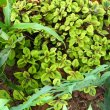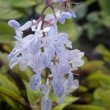| Botanical Name |
Plectranthus ciliatus - Hybrid Easy Gold |
| Family |
Lamiaceae - The mint and salvia family |
| Pronunciation |
plek-TRAN-thus sih-lih-AY-tus |
| Common Name(s) |
English: Plectranthus ciliatus hybrid: Easy Gold
|
| Plant Group |
- Ground Cover A plant with a low-growing, spreading habit, grown specifically to cover the ground.
- Perennial A plant whose life cycle lasts for three or more seasons.
|
| Plant Size |
- Small
| Tree | 4m to 8m |
| Shrub | 50cm to 75cm |
| Perennial/ground cover | 10cm to 20cm |
| Bulb | 20cm to 30cm |
| Succulent | 10cm to 20cm |
|
| Position |
- Canopy Shade Canopy shade is found below closely grown trees where some light filters through. Ideal for the protection of herbaceous plants.
- Deep / Full Shade Shade below spreading evergreen trees where sun's rays are unable to penetrate the canopy at any time. For light sensitive plants
- Light or Dappled Shade Found below trees with sparse, open foliage. Ideal for the protection of herbaceous plants.
- Partial Shade The area is in shade for part of the day and in full sun for part of the day.
|
| General Information |
- Drought Tolerance: Low The plant is unable to survive drought and needs to be watered.
- Drought Tolerance: Moderate The plant is moderately adapted to arid conditions and can survive short periods of drought and high temperatures without extra water.
- Evergreen Plants that have leaves all year round.
- Frost: Half-hardy The plant is able to survive low temperatures and some frost but requires protection against severe frost.
- Water Loving Plants need a regular supply of water and must not be allowed to dry out for any length of time.
- Water Moderate These plants will need some extra watering compared to water-wise plants. Plant them together, in at least some shade and in a convenient proximity to the house so that grey water can be utilised during times of drought.
|
| Specific Information |
The leaves of this plectranthus bring light into a gloomy corner. It thrives in full shade but not dry shade.
|
| Ad Break |
|
| Flowers |
| Description |
|
| Season |
- Autumn Plants will seldom bloom for the entire season as given in the list, but should flower during a period within these parameters.
|
| Colour |
|
| Growth Rate |
- Very Fast Specifying growth rate can be very misleading as there is considerable variation of growth rate depending on type and species of plant, available water, supplementary feeding, mulching and general care, as well as the plants suitability and adaptability to the garden environment.
|
| Plant Uses |
- Attracts bees, butterflies or other insects This plant attracts insects which can be food for birds or other creatures in your garden.
- Border A strip of ground, at the edge of a driveway or path in which ornamental plants or shrubs are planted.
- Container Trees, shrubs and ornamental species that can adapt to growing in a restricted environment.
- Edging A low growing plant that provides softness or definition to the edges of a bed or walkway.
- Filler Either a fast growing tree or shrub used temporarily to fill in an area while the permanent plants grow to a desired size, or a plant used to fill gaps in borders or beds.
- Foliage Plant Plants grown because their foliage is colorful or unique. Many of these plants have insignificant flowers.
- Ground Cover Low-lying plants that spread fast, require minimal maintenance, and cover large expanses or bare areas between bulbs or shrubs. They provide protection from erosion and drought and improve the visual appearance of the garden.
- Interplanting Arranging and planting plants in the garden that have different blooming times and habits of growth, extending the amount of time in which the area is in flower.
- Mass Planting Plants useful for filling a large area with just one or a few kinds of plants spaced close together. Creates a bold, dramatic effect and to reduces maintenance.
- Pot Plant A plant that needs a protected environment on a patio or indoors.
- Stabilize Banks Plant is used to prevent soil erosion because their roots will form a mat that stabilizes the soil and keeps it from washing away in heavy rains.
- Suitable for coastal gardens Plants adapted to dry, sandy soil, forceful wind, limited rainfall and intense sunlight.
|
| Distribution and Habitat |
|
| Planting Suggestions |
Plectranthus will grow and flower with the most meager feeding, but for quick, lush growth and a profusion of flowers, it is worthwhile giving the plants a strong start. Plant plectranthus in well-drained loam or sandy soil with the addition of compost and fertiliser according to your soil needs. Mulch thickly to retain water. Regular watering is also needed but don't over-water - it is best to keep the plants as water wise as possible. Frequent light pruning or tipping is necessary to keep plectranthus compact and bushy. Prune back hard after flowering, during midwinter.
|
| Medicinal Uses |
|
| Ad Break |
|








Comments
Plectranthus ciliates
I've planted some Easy Gold under a tree. Lots of sun hits the spot in the mornings until shade sets in from about noon. Should I move it into a less-sunny area. Regards
Plectranthus ciliatus
Hi Boertjie
The first consideration is whether the plants are happy where they are. If they are thriving, leave them where they are. If they are sparse or of poor colour, then move them to deeper shade. I prefer this variety in a very shady spot as this encourages the lovely variegated colours to show up at their best and it brightens up an otherwise potentially dark spot in the shade. Hope this is of some help. Email me a photo if you like - it makes diagnosis much easier.
frosti have planted
I have planted plectramthus ciliates its a wonderful ground cover for shady spots and surprisingly enough it can handle a little frost (this is the purple one)can this gold on handle frost too ? how do you cut them back ?regards
Plectranthus ciliatus 'Easy gold'
Hi Mandy
I have also found the the purple P. ciliatus copes not only with a little frost, but also with more sun and less water than most other plectranthus varieties. However, the 'Easy gold' is a hybrid and in my experience does not have the staying power of the original plant. I have not tried it in cold situations as I live in a frost-free area, but it isn't happy in sun at all and demands plenty of water to look its best. I suspect it will react quite badly to frost and icy winds. However, if you have frost and it is protected under trees of shrubs, it may survive. There are so few definites in gardening. I would suggest placing a piece or two in an exposed spot and see what happens.
As to cutting back: In autumn, after flowering, I use a pair of hedge shears and cut the whole lot hard, down to the level of the lower leaves. This makes it look quite unattractive but it soon recovers. In early spring when it is shooting strongly, I trim quite a bit off with the shears and in early summer I trim back very lightly. After that I leave it alone until after it has flowered in autumn. This makes a nice cushion and produces lots of flowers. This is how I treat all my low to medium level ground cover plectranthus varieties.
Kind regards
Lorraine
Discuss this plant
Share knowledge, ask a question or give an experience.